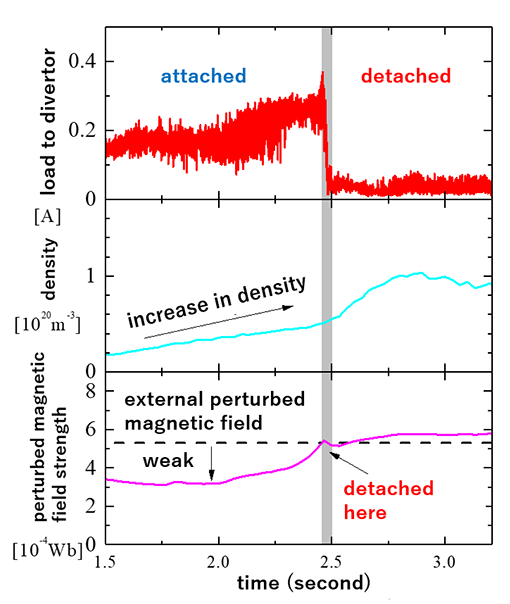HOME > Research Activities > Research Updates >
In the Large Helical Device, the magnetic field container confines the hot plasma. The plasma particles gradually disperse toward the last closed flux surface area of the container. For this reason, plasma diffusing to the edge is led toward the divertor. There, plasma particles and heat are absorbed. In the future fusion reactor, because high heat loads carried to the divertor are anticipated, at the National Institute for Fusion Science we are advancing with research on divertors with higher heat resistance. (For details, see back number 276.)
On the other hand, at the LHD, research that seeks to lower the heat load carried to the divertor is being undertaken through controlling the plasma skillfully. By cooling the edge plasma by adding impurity gases such as argon, we attempt to change those plasma particles to atoms and molecules before the plasma particles reach the divertor. That is, we attempt to change the plasma particles to neutral gas. By doing so, from the condition of “attached” where the plasma arrives at the divertor, the plasma changes to the condition of “non-arrival,” and the heat load to the divertor can be reduced. This “non-arrival” condition is called “detached plasma.” However, if we attempt to produce a detached plasma, should control of the edge plasma be unsuccessful, impurities will enter into the plasma core and the plasma’s core temperature will fall. In order to avoid that, first, it is necessary to clarify the mechanism of the transition to the detached plasma.
It is thought that the magnetic field structure in the edge region is deeply connected to the transition to the detached plasma. In the LHD, in addition to the powerful magnetic field of the container produced by the superconducting coils, for various reasons is generated weak turbulence of the magnetic field. This turbulence is called the “perturbed magnetic field.” (“Perturbation” means extremely small turbulence.) In the LHD, using the auxiliary coils attached to the outside of the vacuum vessel, we purposely add a perturbed magnetic field and conduct research that investigates the plasma response. Until now, when we have added a perturbed magnetic field using an auxiliary coil, the high temperature core plasma becomes easy to maintain. And, we have observed that it becomes easier to achieve a detached plasma when we strengthen that magnetic field. Further, the perturbed magnetic field becomes stronger and weaker according to the plasma’s response. This is because the magnetic field changes according to movement of the plasma inside the vacuum vessel which is a collection of charged particles. The strength of the perturbed magnetic field is determined by various factors, but until now, it was thought that the transition to a detached plasma occurs at the fixed value. Here, we conducted an experiment to confirm this idea.
In the experiment, by using an auxiliary coil, we add the external perturbed magnetic field and gradually raise the plasma density. When the density rises, because the plasma reaction changes the strength of the perturbed magnetic field also changes. We observed a perturbed magnetic field in a particular location of the edge plasma, then it was found that the perturbed magnetic field immediately following the plasma generation was weak compared to the external perturbed field by the auxiliary coils (the perturbed magnetic field is being weakened by the plasma), but when the density was made to gradually rise, the perturbed magnetic field slowly strengthened. Then, the strength of the perturbed magnetic field was approximately equal to the strength of the external perturbed magnetic field from the auxiliary coils, and we observed the transition to the detached plasma. When we set various values for the strength of the external perturbed magnetic field based upon the auxiliary coils, similar trends were observed. From this, we learned that the value of the perturbed magnetic field at the time of the transition to the detached plasma was not fixed, and the strength of the external perturbed magnetic field was possible to choose various values depending on the external perturbed magnetic field strength by the auxiliary coils. This suggests that there are various magnetic field structures at the time of the transition to the detached plasma. At present, we are now undertaking detailed analyses of the experimental results considering that the mechanism by which the plasma strengthens the perturbed magnetic field is to be the key for the transition to a detached plasma.
Through this research we aim to establish methods for producing gentle detached plasmas appropriate for the divertor in the future fusion reactor.

Experimental results: In the condition in which the strength of the magnetic field due to the auxiliary coils is fixed, we increase plasma density. The perturbed magnetic field grows gradually stronger, and at approximately when it became equivalent to the strength of the external perturbed magnetic field, the transition to the non-attached (detached) condition occurs from the condition in which the plasma is attached to the divertor, and the load borne to the divertor decreases.
